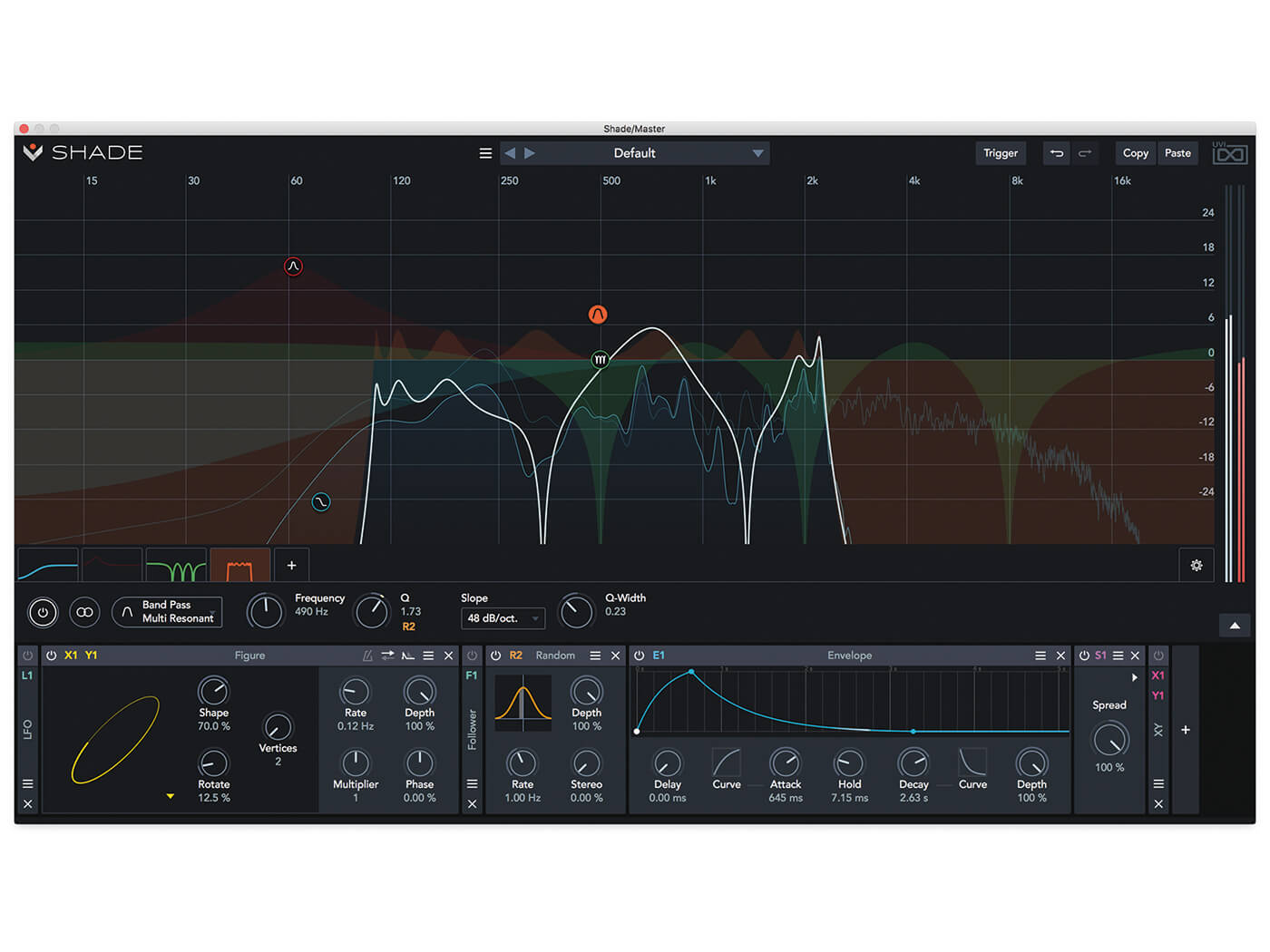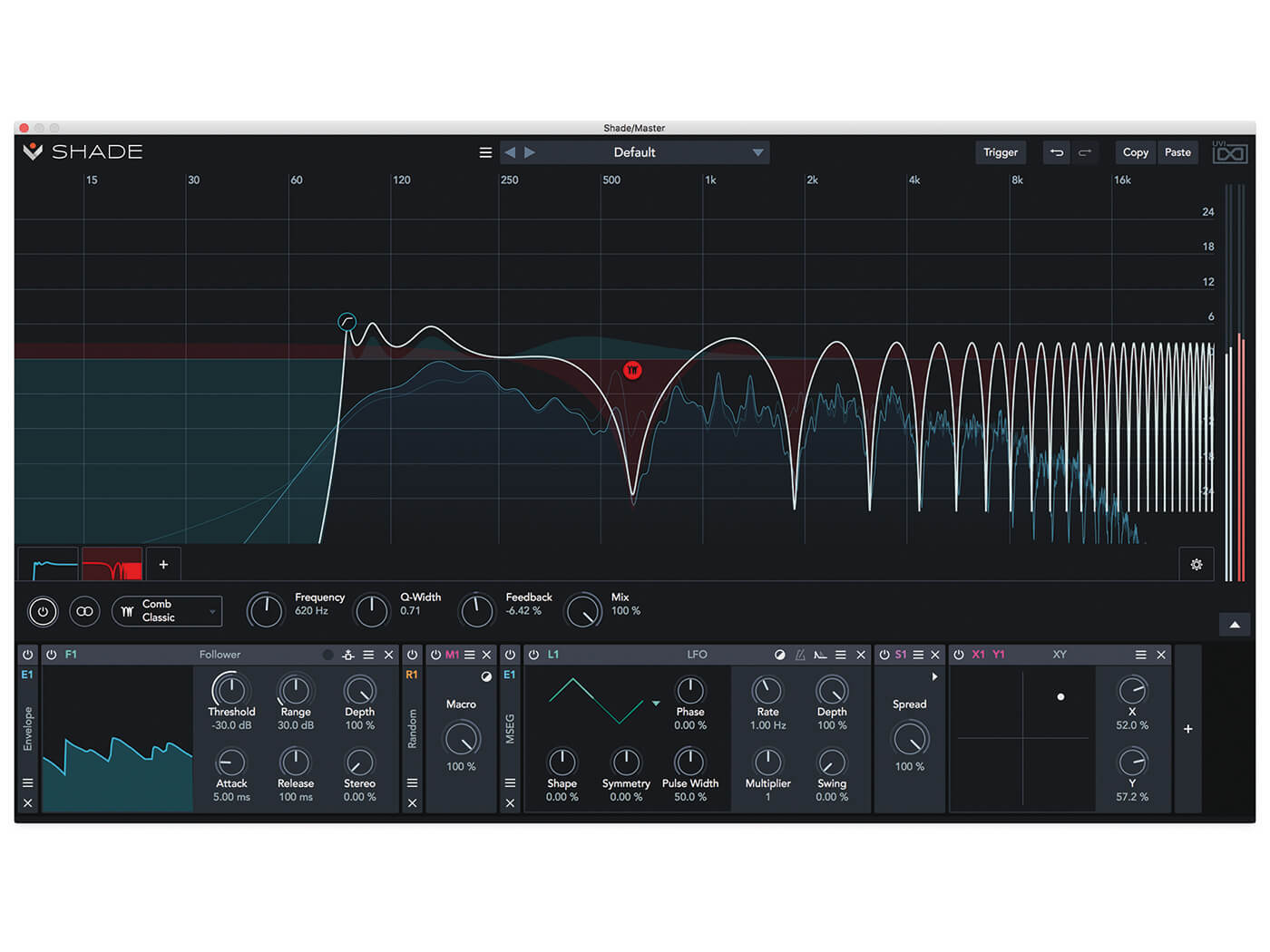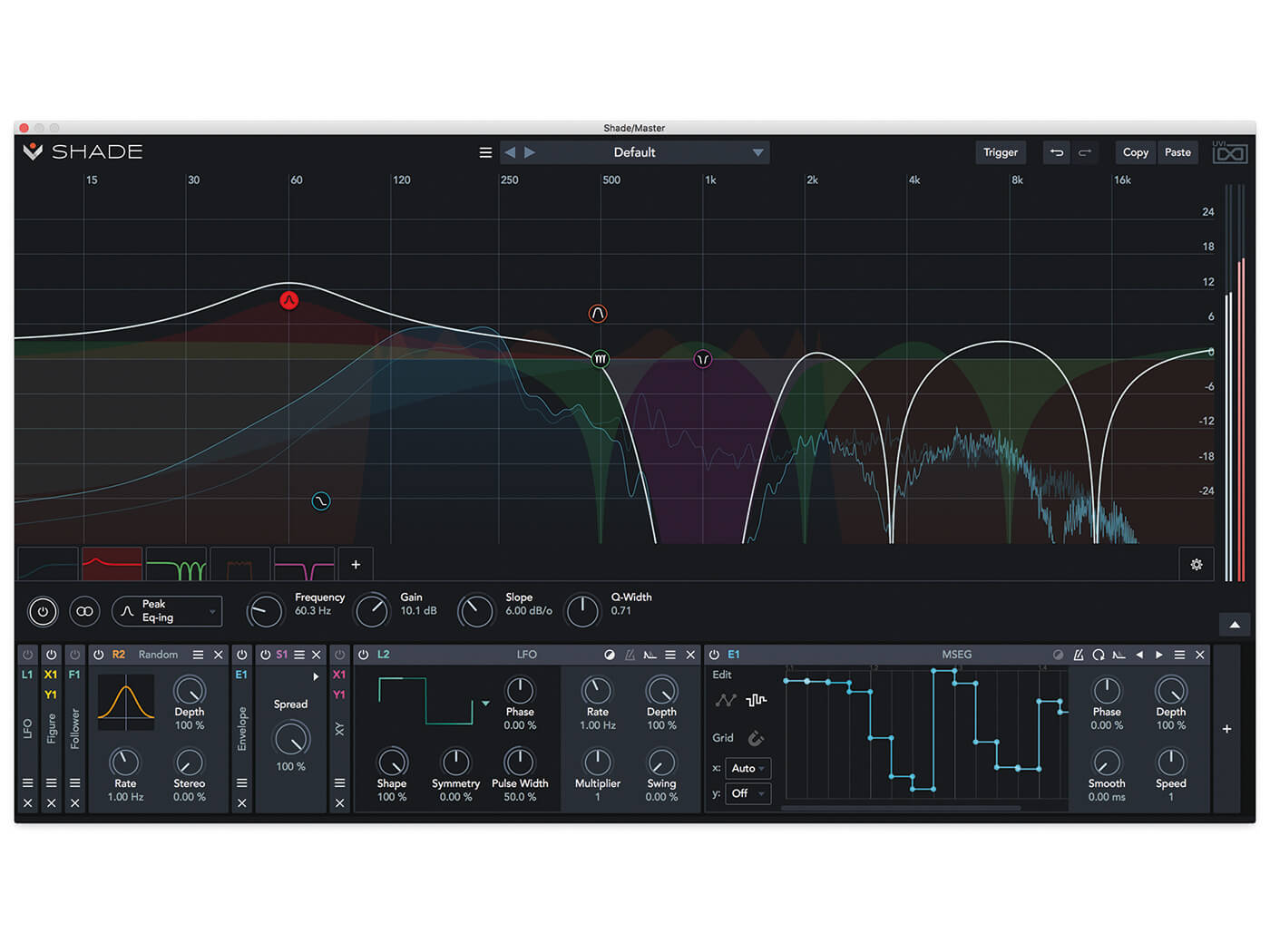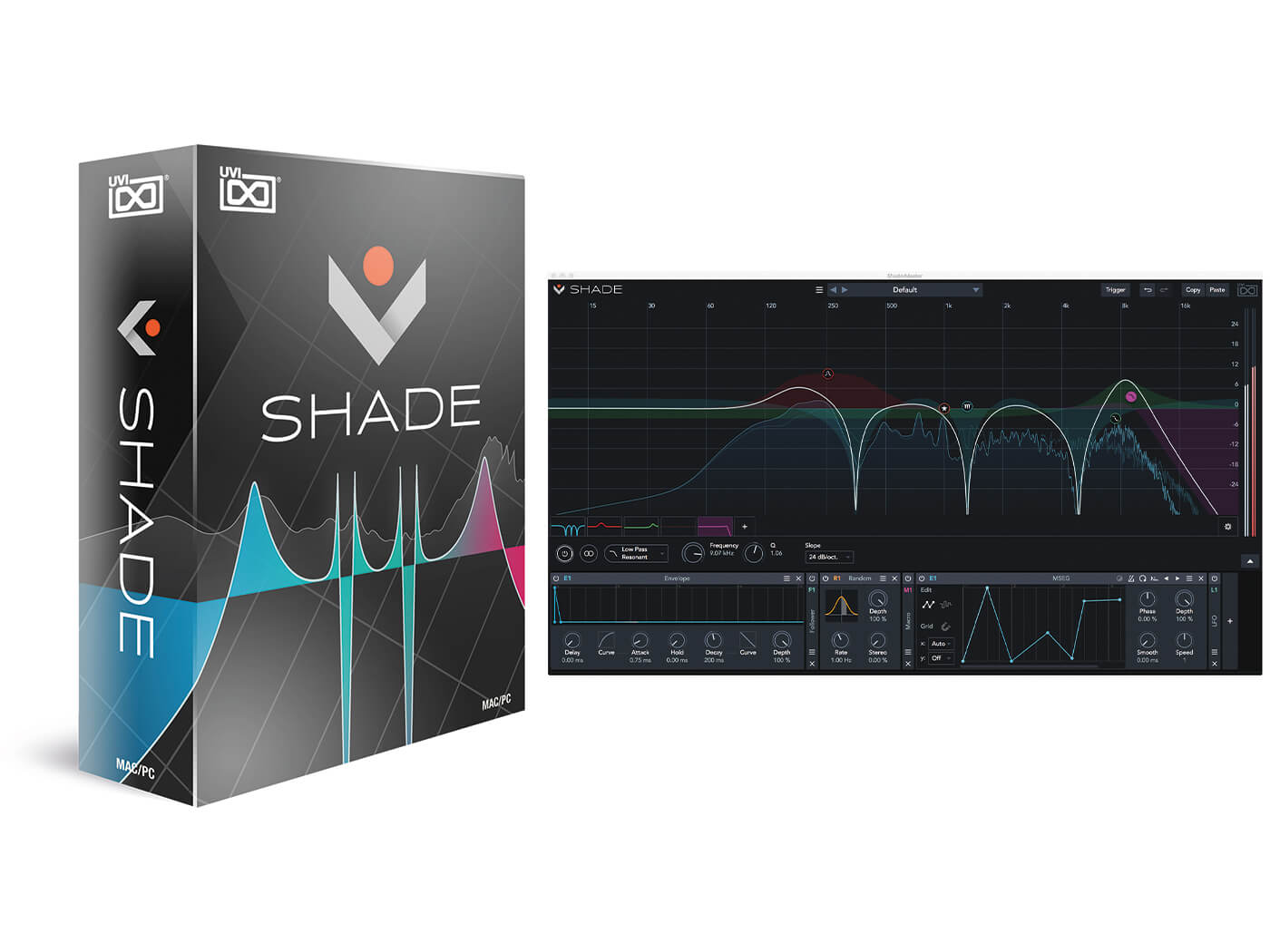Review: UVI Shade
Combining EQ, filtering and swaths of meandering modulation, UVIs new effects plug-in draws the spotlight, but will it leave others in the Shade?


Price £115
Contact UVI
French audio pioneers UVI has quite the reputation, thanks to the acclaimed Falcon 2 soft-synth, coupled with numerous expansion libraries, designed to either work within its framework, or within the more basic and free Workstation plug-in. Encompassing vintage kit and acoustic classics, UVI’s products are usually incredibly easy to get started with, with a broad focus of samples rooted in the now, with a sideline in breathing new life into vintage sounds. The company’s expanding line-up of great effects-based plug-ins, is joined by this latest release, which dips another toe into the classic concept pool, but with modern production technique in mind.

Throwing shade
While it might not be immediately obvious from the name, Shade is classed as an advanced EQ, mix tool and creative filter. Given the thin line between equalisation and filtering, it’s easy to comprehend that these facets might collide. Where Shade breaks out of the EQ construct is with its ability to modulate parameters, for easy creation of movement and modulation within a track. Other associated effects also put in an appearance, leading UVI to describe the product as ‘…a next-gen Swiss Army knife filtering tool.’ covering many bases, within a singular plug-in.
The format is pretty traditional, with a spectrum analyser display swallowing up most of the plug-ins’ real estate. This is useful for monitoring an incoming signal, but starts to whirl like a Tasmanian devil, with crisp animation, from the moment any of the more engaging effects are activated.
The lower part of the plug-in benefits from a hide/reveal arrow, allowing for a degree of window minimisation. Presets are accessed via a categorised menu format, from the top of the plug-in.
To get a flavour of what Shade can do, our first point of processing is with a basic low pass filter. Double-clicking within the analyser section immediately brings this option to life, although a secondary click will throw open a further filter menu, although any filter may also be changed after selection. Once initiated, mouse movement allows control of frequency location and associated resonance or Q. So far so simple. Filter values may then be exacted via the pots, exhibited directly below the analyser.
Apart from a mirroring of Frequency and Q in pot form, it’s also possible to switch filter slope, from the beautifully crunchy 12db/oct, all the way up to an incredibly precise 2000db/oct. There are plenty of further slope amounts available in between, increasing by 6db each time until we reach 48db, at which point larger gaps increase, taking in 60db, 72db and 96db.
The basic low pass resonant filtering is very smooth. Our first test was undertaken with a soft-synth producing a wide open saw-tooth, with a resultant tone which is musical and indulgently creamy. This obviously changes with each mutation of slope, with an overall colour that sounds very natural and classic.

All filter, no filler
With the basics assured, there are a whopping thirty-five filter shapes available, from the basic low pass through to comprehensive comb filtering. Staying in low pass territory, the Multi Resonant filter shape multiplies the number of resonant peaks, providing plenty of Q-based ripples in the frequency plot, immediately turning very throaty, once any substantial increase in the Q ratio is applied.
Another cool trick which may be applied at this stage, is the option to switch the stereoscopic mode. Apart from the basic stereo or mono operation, filters may be applied to the left or right side, leaving the opposite side unadulterated. Any multi-peak processing creates a unique effect in this configuration, especially once the frequency is mutated in realtime.
Moving away from Low pass modes, other modelled filters take in high pass, notch and band formations, before moving into the territory of phasers, flangers and comb filters. Shade is not only credible and impressive at the individual level, but also as a sum of parts. Multiple filter shapes can be applied, with each allocated an on-screen colour via the row of filter-building-blocks, located at the bottom of the analyser window. A click of the filter you wish to alter brings the appropriate parameters to the fore, while the click and drag option remains available too, from within the analyser segment of the window.
Modulate to animate
The effect that multiple filter shapes can superimpose on each other creates some outstanding interest, in texture and tonal colour. Unsurprisingly, the more complex the filters get, the more elaborate the tonal colours that emerge. While in static mode, this is fairly predictable and stable, but with the introduction of modulation sources, things can get insane and wild.
The filters are accompanied by nine different variations of modulation source. These include basic LFOs and envelopes, alongside randomisation, and the MSEG, which stands for Multi-Step Envelope Generator. This can be deployed to create gating effects, which can alter both amplitude and filter colour. However, the effect which had us enthralled from the point of discovery is the Figure modulator. This little device literally draws shapes, dancing in plain or more complex circular patterns, all for the purposes of modulation across an X-Y field. It’s endearing to watch and inspiring to hear.
Modulation is dictated by dragging and dropping your modulation source on the required parameter. If you were to do this with LFO, you’ll most likely see the analyser graphic immediately start to pulse in time to the LFO rate, which may run free or lock to your DAWs tempo, with the sensible ability to allow for clock division by note value.
Applying the Figure modulator to the Comb Filter or Phaser, the effected output dances and flurries to a pulse dictated by your DAW. Any pad-like component of your track can be immediately repurposed, for greater interest and depth.
Follow the light
The impressive nature of Shade allows for complicated effects or subtle processing, at whichever level you require. The comparative ease with which it is possible to exploit numerous and simultaneous modulation sources will create some beautifully complex colours.
Testimony to the ease of operation that we were able to dive right into the constituent components and get creative, but if you prefer to get a flavour of Shade’s capacity from presets, there are plenty of those to keep you engaged and impressed. You’ll find useful basics like Autopan residing next door to complex animations.
There’s something for every occasion, with a sound that is reflectively UVI; laden with depth and quality, and a breeze to use. It’ll have your mixes stepping out of the darkness and into the limelight!
Do I really need this?

It would be very easy to right off Shade as a filter-based or EQ plug-in. While it has these elements at its core, it takes the concept to the very boundary of processing, moving into associated areas, such as phasers and flangers. The comprehensive set of filters are incredibly impressive, in both sound and usability, but it is the modulation routing where the plug-in awakens, providing movement and interest where basic synth sounds might feel a little lacklustre. In line with UVIs ethos, it’s a sharply designed plug-in, in both look and sound, with production ready features which sound great, right out of the box. Meanwhile, the easy to use interface invites tinkering or building of effects, from the ground-up. It’ll provide texture, colour, grit and groove, all in a single plug-in.
Key features
- Advanced EQ, mix tool and powerful creative effect
- Next-generation filtering and modulation tool
- Thirty-five unique filter types available, from subtle to insane!
- Comprehensive modulation routing system, via nine modulators
- 200MB of disk space required
- Requires iLok account, for authorisation
- Available in AU, AAX, VST and VST3 plug-in formats
Alternatives
Cableguys
Shaperbox 2 Bundle £175
The highly functional AU and VST plug-in from Cableguys recently reached version 2. Its intuitive interface, coupled with large numbers of presets, results in a package which is full to the brim with content, while allowing easy exploration and further editing.
Soundtoys
FilterFreak £120
The sound of FilterFreak is inspired by the resonant ladder filter from Moog. It’s very desirable sonically, while also including numerous step-editing and LFO/Envelope modulation options. It is also available as part of the highly regarded Soundtoys 5 suite.